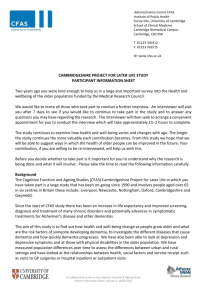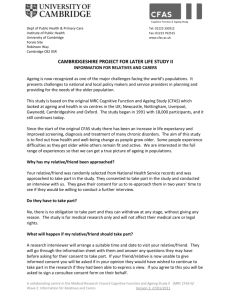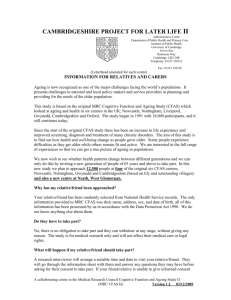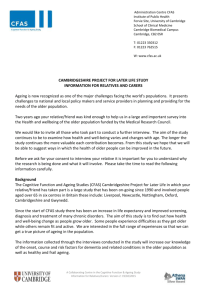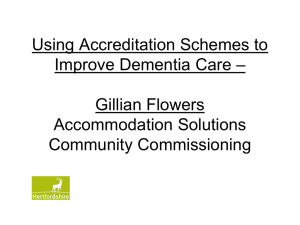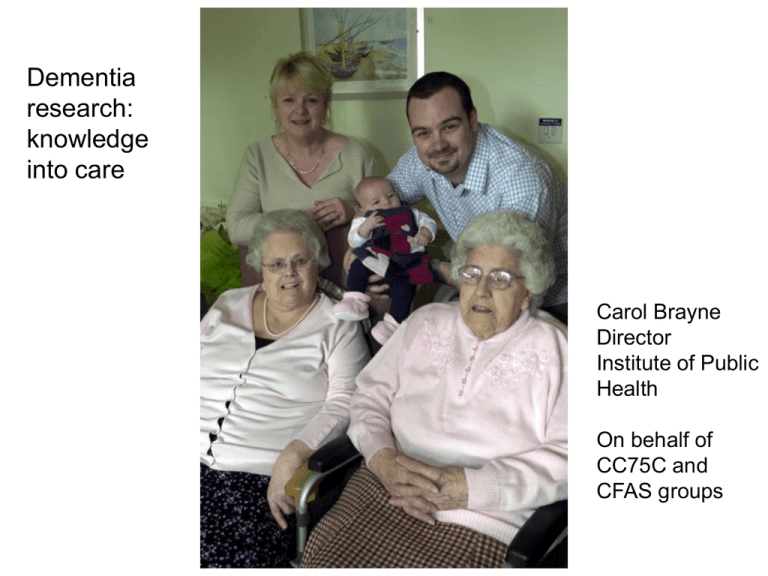
Dementia
research:
knowledge
into care
Carol Brayne
Director
Institute of Public
Health
On behalf of
CC75C and
CFAS groups
Numerators
How do we create evidence on
which to base decisions?
Some examples:
• Anecdote
• Descriptions of ‘best practice’ collected
from experienced experts
• Collections of actual experience such as
case series
• Observing particular groups/services and
collecting information
• Systematic approach
Framing questions
• Systematic approaches need a specific
question or questions to be asked
• Then research/evidence synthesis can be
designed to answer that question as best
as possible
• Once the question is framed we can work
out whether it is answerable currently
Impossible questions
• Is dementia more common now than forty
years ago?
• Why?
• Is respite care cost effective?
• Why?
• How can we make these questions
answerable?
Making questions answerable
• Deconstruct them
• Is respite care cost effective?
• Need to define respite care and cost effective, then
define particular group offered respite care, then the
nature of the intervention such as type of location, length
of stay, circumstances of offering respite care etc
• Then observational evidence can be accrued and
collated
• Then to answer the question definitively all the
experience can be used to design a trial with collection
of all the necessary information
• Will the results be relevant to those to whom any
recommendation will be applied
What have we been working on in
this area for last 25 years?
• Two major studies + others
• CC75C
• CFAS
Cambridge City over-75s Cohort –
25 years old
• Original intention evaluation of
community resource team
impact on care quality and
outcomes
• Prevalence, incidence, risk
• Driving behaviours
• Falls
• Frailty
• End of life
• Neuropathology
Originally called
Hughes Hall Project
for Later Life,
Then Cambridge
Project for Later Life
Cambridge City over-75s Cohort
• Population-based - community and care homes
• Changes in cognition and function with ageing
• Began 1985/7 screening for dementia
(O’Connor, Pollitt)
• Repeated surveys
• 95% consent Year 0, highly representative
• Latest survey just completed, all over 100
• Current work on QoL/EoL survey = Year 21
• Brain donation programme since 1986
Data collected :
•
•
•
•
•
•
•
•
•
Cognitive function
Socio-demographics
Family / social contacts
Service contact
Mood / subjective well-being
Activities of daily living
Physical health
Medication
Detailed neuropathology in 240 donors
Incidence in Europe,
meta-analysis (Jorm, 1998)
300
n/1000 pyar
250
200
150
Rate/1000 pyar
100
50
0
65-69 70-74 75-79
80-84 85-89
age group
90+
Response profiles as a function of
dropout and death
28
Mean MMSE
26
24
All interviews
Death after year 6
Refusal after year 6
Death after year 2
Refusal after year 2
Death after year 0
Refusal after year 0
22
20
0
2
4
6
Time
8
10
TRANSFERS IN PLACE OF RESIDENCE OR CARE AT THE END OF LIFE
Community
n=166 (52%)
Sheltered housing
n=53 (17%)
160
1
1
46
Residential care home
n=68 (21%)
2
4
Care home with nursing
n=20 (6%)
3
63
4
2
20
Sheltered housing
n=47 (15%)
Residential care home
n=71 (22%)
Place of
residence
when last
surveyed
in the year
before death
10
1
2
Community
n=161 (50%)
Hospital: NHS long-stay
n=13 (4%)
1
Care home with nursing
n=30 (9%)
Hospital: NHS long-stay
n=11 (3%)
Usual
address
at death
Place
of death
1
11
5
81
30
16
3
15
52
Community
n=52 (16%)
9
Sheltered housing
n=9 (3%)
4
2
Hospice
n=6 (2%)
7
55
Residential care home
n=62 (19%)
2
1
26
Care home with nursing
n=29 (9%)
Hospital: NHS long-stay
Hospital: acute
General
n=29
NHS
n=128
Psychiatric
n=3
All long-stay n=32 (10%)
Private
n=2
Acute n=130 (41%)
MRC Cognitive Function and Ageing
Study
(www.cfas.ac.uk)
MRC CFAS – brief introduction
• Longitudinal two wave two phase study
initially
• 13,004 individuals (5 identical centres)
• 5,300 individuals (1 non identical centre)
• Aged 65 and above in 1991, equal weight
• Rural and urban sites
• Population sampling including institutions
• ~ 80% response rate at each stage
• Followed up at ‘regular’ intervals
MRC CFAS
THE MRC CFAS STUDY DESIGN
1991
S0 Prevalence Screen
N= 13004
A0 Prevalence Assessment
N= 2640
F1 Annual Follow-up
N= 920
S2 Incidence Screen
N= 7176
C2 Combined Screen/Assess
N= 1651
1992
1993
1994
1995
A2 Combined Screen/Assess
N= 1463
F3 Annual Follow-up
N= 590
1996
1997
C6 Combined Screen/Assess
N= 1736
C8 Combined Screen/Assess
N= 390
1998
1999
2000
C10 Combined Screen/Assess
N= 3145
2001
Prevalence by centre
Men
14
Women
12
Prevalence (%)
10
8
6
4
2
0
Camb
Gw yn
New c
Nott
Oxfd
Camb
Gw yn
New c
Nott
Oxfd
Adapted from MRC CFAS 1998
Percentage below MMSE cutpoints
by age
80
70
60
50
40
17/18
21/22
30
24/25
20
10
0
65-69
70-74
75-79
80-84
Age group
85-89
90+
%
Clinical norms
30
90th
75th
25
MMSE
20
50th
15
25th
10
10th
5
0
65
70
75
80
Age in years
85
90
95
Prevalence of reported vascular and other risk factors
% of Population
65-74
men
women
75+
men women
head injury
18
8
8
7
HBP
32
37
25
34
angina
16
10
16
14
heart attack
15
6
14
9
stroke
6
4
11
8
diabetes
6
5
8
6
Risk Factors for Incident Dementia in CFAS
Age (90+ year vs 65+ years)
25.6 (11.6-56.9)
Self reported health (Poor vs good)
3.9
(2.2-6.4)
Parkinson’s disease (Yes vs No)
3.5
(1.3-9.3)
Stroke (Yes vs No)
2.1
(1.1-4.2)
Education (<9 vs 10+)
1.9
(1.3-2.2)
Sex (women vs men)
1.6
(1.1-2.4)
NOTE1 Social Class and other medical/family history (including genetics) were not found to
be strongly associated with dementia
NOTE2 Alcohol and smoking (never, past, current) neither strongly predictive or protective
How does mild cognitive impairment do as a clinical label?
Review of Clinic vs. Population-Based Samples
Population Based Outcome
Clinic Based Outcome
Dementia distribution for people over 65 years old in 2010
Source: Population size come from ONS Statistics.
Prevalence of Dementia come from Dementia UK full report 2007.
Estimated Dementia distribution for people over 65 years old in 2050
Source: ONS Statistics. Dementia UK full report 2007.
Policy and local service input
•
•
•
•
•
Director of Public Health Reports annually
Joint Strategic Needs Assessment
National Strategic Framework
Dementia UK and revised estimates
Ministerial Advisory Group on Dementia
Research
THE CAMBRIDGE CITY OVER-75s COHORT STUDY
(CC75C)
Website: http://www.cc75c.group.cam.ac.uk
with links to published papers and abstracts:
- prevalence, incidence + changes in cognitive
impairment
- neuropsychology, neurobiology, genetics
- clinical studies e.g. hospital and other service use
carers of demented relatives
disability
depression
the “oldest old”
attitudes to dying
- neuropathological investigations
International Journal of Epidemiology cohort profile
(2007)
Current MRC CFAS collaborative group
• Cambridge Department of Public Health (Barnes, Brayne,
Keage, McDougall, Savva, Stephan, Zaccai, Zhao, Xie) &
MRC Biostatistics Unit (Gao, Johnson, Matthews, Muniz)
• Exeter (Melzer, Frayling)
• Gwynedd and Liverpool (McCracken)
• Herriott Watt (McDonald)
• IoP (Dewey)
• Leicester (Jagger, Matthews)
• Newcastle (McKeith, Bond, Polvikovski)
• Nottingham (Lowe)
• Oxford (Evans, Esiri, Wilcock, Clarke)
• Queen Mary (Parry), LSE (Comas Herrera, Wittenberg)
• Sheffield (Ince, Forster, Wharton)
• Southampton (Nicoll, Stewart)
• Lay members: Mr Simon Harrison, Mrs Brenda Barber
•
GSK (BPSD analysis support) Davidson, Ishihara


